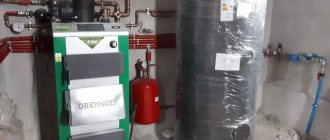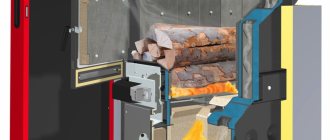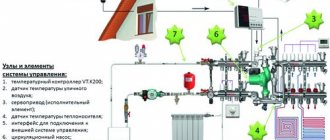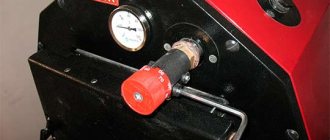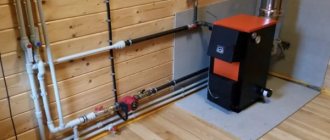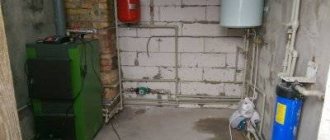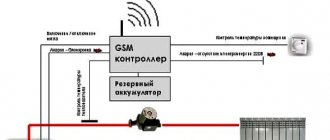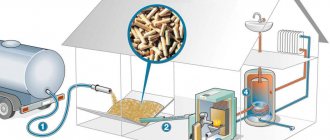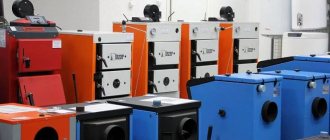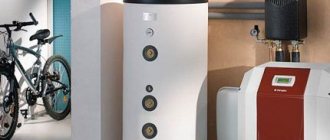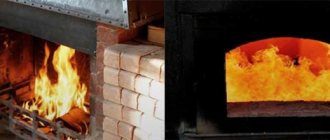Boilers operating on solid fuels are widespread due to their availability, versatility, autonomy, environmental friendliness and ease of use. By squeezing maximum volumes of heat energy from firewood or briquettes, they transfer it to the heat carrier with virtually no losses. Effective control of a solid fuel boiler is carried out using automated devices. They are responsible for the fuel combustion process with the production of high efficiency (efficiency factor) and significant resource savings.
Advantages provided by an automation kit for a solid fuel boiler
There are no accidents or coincidences in our world, and people had to automate the process of burning solid fuel in a heating boiler for a reason - there are a number of good reasons for this.
The most important of them is safety. Anyone who uses solid fuel to heat a home probably knows the consequences of overheating the coolant - boiling water in the boiler can even lead to an explosion with serious consequences. First of all, automatic control allows you to control exactly this moment - a person is a forgetful creature by nature, and automation works according to a program, and there is no such thing as “forgetting” for it. In addition, automation of a solid fuel boiler provides a number of other benefits to humans.
- Optimizing the climate inside the house. It eliminates sudden changes in temperature - when the boiler is just loaded and combustion reaches its peak, the house is hot, and when the firebox is empty, the house becomes cold. Automation removes the first rise in temperature towards an increase.
- Fuel economy. This occurs due to the operation of the thermostat. Having brought the temperature of the coolant to the set value, the automation stops burning, switching the boiler to smoldering mode - slow heating occurs, which consumes much less fuel.
- The task of controlling the combustion process is removed from the person. That is, you loaded the firebox full and went about your business - all that remains is not to miss the next loading of the boiler.
This concerns the primary tasks that automation for a solid fuel boiler is designed to solve. In addition to them, depending on its complexity, automatic control of fuel combustion may have additional options that expand the capabilities.
Advantages and disadvantages
Automation for solid fuel furnaces has a large number of advantages, and only one drawback. They will be discussed below.
So, the advantages:
- Automatic temperature adjustment. Previously, a person had to set the damper at the right level to increase and decrease the temperature in the boiler. Now, modern solid fuel stoves will take care of this themselves. A person only needs to adjust the temperature and that’s it! During operation, the boiler will check the temperature and, using special devices such as a fan or pump, will limit or increase the air supply. If the temperature inside the boiler rises, the air supply is automatically limited, and if the temperature is below the set norm, the air supply is increased.
- Independent operation of the boiler. Previously, if the owner needed to go somewhere for several days, he had to completely turn off the boiler, that is, take it out of the operating phase. With modern units everything is different. Thanks to automation, you can set the minimum parameters for the stove before leaving, and when you arrive, the house will be warm and cozy.
- Ignition of fuel. Now there is no need to ignite the fuel. The system will do this automatically.
- Safety. Modern units have the highest level of safety. The system is equipped with special devices that are capable of detecting the breakdown or failure of one or another element. This will be indicated by a sharp jump in temperature, change in pressure, etc. If this is detected, the system automatically stops operation and makes a sound, so the owner can quickly find out about the malfunction and call a specialist.
- Electricity reserve. If the power supply is suddenly interrupted, the unit will continue to operate for some time.
- Self-loading of fuel. Modern boilers have a special tank in which firewood or other types of fuel are stored. Automation is capable of automatically loading fuel into the combustion chamber. Now the ash pan is also cleaned automatically without human intervention.
- Control system. There are types of automation where a person, by clicking on special screen elements, must set certain values. But there are also options where a person does not need to approach the system and can simply control the remote control, and the signal is picked up at a fairly large distance.
These are the advantages of automation. It must be said that all this is aimed at making human life as comfortable as possible and the boiler as safe as possible. Automation has only one drawback - energy dependence.
How to choose the right boiler connection diagram
In order to keep the house warm, it is not enough to know what heating schemes are available with a solid fuel boiler. Craftsmen who have been creating heating systems for many years give the following recommendations:
- When creating a drawing of a heating circuit for a solid fuel boiler, you should first familiarize yourself with the types and operating principles of such heat generators. This can be a constant or long-burning heater, a pyrolysis or pellet unit, or a buffer. Each of these devices has its own operating criteria, which may be disadvantages for some, and advantages for others.
- To get an ideal heat supply scheme, you need to be able to combine the functioning of the boiler with the tank, since this element accumulates thermal energy. This is justified by the fact that the element heating the water can change its temperature in the range from 60 to 90 degrees. There is no constant indicator. Since solid fuel boilers are inert devices, this distinguishes them favorably from gas, diesel and electric analogues.
- When choosing a heating scheme, you need to objectively assess the risk of power outages. If there are frequent power outages in the area, then a system with a water pump will not only not pay for itself, but may quickly fail. Therefore, it is better to choose a type of heating with natural circulation.
- When choosing a piping, it is worth considering in advance the safety lines between the boiler and the tank. They are located at the points of the inlet and outlet pipes so that they are as close as possible to the water heater. Also, to achieve maximum effect, you need to try to keep the distance between the boiler and expansion tank to a minimum. But it is no longer possible to install safety valves or taps here.
- If a scheme with a pump was chosen, then it is installed on the return pipe, as close as possible to the heat generator. Thus, even if the lights are turned off and the pump stops working, the water will continue to move along the circuit, that is, minimal heat will be retained. The device must be installed along a bypass route. Only then will it be possible to disconnect it from the network (if necessary), and shut off the circuit itself using taps.
- There is such a thing as bypass. These are jumpers with taps that are placed between the supply line and the return pipe. This arrangement facilitates the return of “extra” hot water when the volume changes through the thermostat.
- A stainless steel valve must be installed in the chimney pipe. Since there is moisture in the smoke, albeit in small quantities, it is this that can provoke the destruction of the internal part.
Tying is a process that deserves special attention. Therefore, they design and install it only if they have complete confidence in their abilities. Nikolay Avramenko, 51 years old
Energodar
Nikolay Avramenko, 51 years old, Energodar
Having read the article, I would like to add my note. The topic of operational characteristics of solid fuel boilers was touched upon here. It was indicated that they have such a feature as high inertia. I would like to say that this phenomenon is not typical for pellet boilers. This is due to the fact that such devices have a burner that receives wood pellets in portions. Therefore, when the supply of raw materials stops, the flame immediately goes out. Although such boilers are not so cheap.
Anton Abramov, 29 years old, Omsk
At one time, I was interested in the work of solid fuel boilers, as they offered me a position related to this area. I would like to leave a few words about the thermostat and its regulatory features. You need to understand that when a certain temperature is set, for example, at 85 degrees, even though the damper is closed, the burning and smoldering continues. Because of this, the water still heats up a couple of degrees, and only then it will be established accurately. Therefore, you should not turn the thermostat back and forth, otherwise this may lead to breakdown of the entire system.
Nikita Karpenko, 37 years old, Arkhangelsk
When we built a house outside the city, we planned to live there all year round. The time came when it came to heating, and I settled on a closed-type system with natural circulation. Firstly, it was quite easy for me to create it with my own hands, and secondly, we were already a little limited in money. I didn’t have any particular problems with the installation, but when the first cold weather arrived, I realized that there was clearly not enough heat for the house. So at school, I was quite good at physics, and I realized that heat is “lost” in areas where the pipes were left open. Taking a roll of mineral wool, I wrapped all the pipes that run in open areas. Literally by the end of the first day, our family felt a significant warming in the rooms. Therefore, you need to remember such moments.
Connecting emergency systems
Elements of emergency systems in the wiring diagram are used for the following purposes:
- protection against increasing the maximum operating pressure in the system;
- protection against exceeding the maximum permissible output temperature of the coolant, overheating of the boiler and heating system elements;
- preventing the formation of condensation in the boiler due to a large temperature difference of the coolant at the inlet and outlet of the device.
Safety valve
Protection of the boiler and system elements when the operating pressure of the heat-carrying liquid is exceeded is provided by a safety valve installed on the supply line at the outlet of the boiler. Such a valve can be part of a boiler safety group, which is built into the boiler itself or connected separately.
How does a safety valve work?
A drain hose is connected to the pressure relief port of the valve. When the valve is activated, excess heat-carrying liquid from the system is drained into the sewer through a hose.
Emergency heat exchanger
An emergency heat exchanger is needed to protect the boiler and system elements from overheating.
Equipment overheating can occur in two cases:
- when the power generated by the boiler exceeds that required for heat consumers;
- when the circulation pump stops working due to its breakdown or power outage.
The heat exchanger consists of a cooling module and a thermal valve with a remote thermal sensor set to a certain temperature. They can be installed inside the boiler itself or separately on the coolant supply line to the heating system.
How does a heat exchanger work?
When the permissible temperature is exceeded, the thermal valve is activated by a signal from the thermal sensor.
It supplies cold water from the water supply line to the cooling module, in which excess heat is removed from the coolant. From the cooling module, the water that has removed the heat goes into the sewer system.
Additional circuit
Protection of the boiler from overheating in systems with forced circulation can also be ensured using an additional circuit with natural circulation, to which a storage tank for hot water is connected.
Boiler piping with an additional circuit
During normal operation of the system, the pressure created by the circulation pump in the main circuit closes the additional circuit using a check valve, preventing the heat-carrying fluid from circulating in it.
When the pump is turned off for any reason, the forced circulation of the coolant in the main circuit stops and natural circulation begins in the additional circuit. Due to this, the heat-carrying liquid in the system is cooled to the required temperature.
Thermostatic mixer
Maintaining the minimum required temperature at the boiler inlet to prevent the formation of condensation in it is ensured by a thermostatic mixer.
The device is installed on the return pipeline and connected to the supply line using a jumper (bypass).
Installation of a thermostatic mixer
When the temperature of the coolant in the return line is low, the thermal mixer opens and mixes hot liquid into it. After reaching the desired temperature, the thermal mixer closes and stops supplying hot coolant through the bypass to the return.
This scheme can be used in systems with any type of circulation.
Is it possible to make a solid fuel boiler with your own hands from available materials?
Advantages of gas boilers
Gas heating systems have the following advantages:
- Automation ensures stable operation and ease of operation of the heating unit.
- Gas boilers quickly pay for themselves due to efficient operation and low fuel costs.
- Capable of heating large areas of premises.
- The operating principle is designed for a truly long service life.
- Demonstrate high efficiency indicators.
- Does not force the user to monitor the flame level. Gas is supplied continuously, and if the burner goes out, the automatic system for gas heating boilers reports this to the system and resumes combustion.
- The boiler produces more energy than it consumes itself.
Kinds
Automation for solid fuel units can be classified according to autonomy.
There are two types here:
- Automation that does not require electricity.
- Automation powered by electricity. This type performs all its functions only if it is connected to a power source. Of course, it is also equipped with a backup reserve if the power supply is suddenly interrupted. So, even if the electricity supply is interrupted, the boiler will continue to work for some time.
Of these two options, it is the second option that is recommended, since it has a large number of diverse functions and effectively fulfills its obligations.
Rules for organizing solid fuel heating
The main difference that a heating system with a closed-type solid fuel boiler has is the type of fuel used. Coal, firewood, peat or fuel briquettes are used as energy carriers. All of them are characterized by high energy intensity and, as a result, intense heat release.
In order to make heating with a solid fuel boiler with your own hands, you will need to familiarize yourself with the rules of its organization. They directly depend on the chosen scheme, the pipe distribution system and the coolant used.
A characteristic feature is the correct installation of heating with a solid fuel boiler. The source of thermal energy and fuel must be located in different rooms, and in addition to the installation rules, safety measures for the operation of heating must be observed.
The basic rules for the design and practical implementation of heating systems using solid fuel boilers and stoves are the following:
- Use of non-combustible materials. When installing a stove or boiler, the floor, walls and ceiling in the chimney area must be fireproof. Those. if exposed to high temperatures, these materials should not spontaneously ignite or smolder;
- Work stabilization. The main danger when operating a solid fuel boiler for water heating is overheating of the water in the heat exchanger. To prevent this, the boiler or stove provides the ability to regulate the air supply necessary to maintain the combustion process of wood. This could be a system of valves connected to a mechanical temperature controller;
- Supply and exhaust ventilation. The classic installation scheme for heating from a solid fuel boiler provides for air exchange in the room where the equipment is installed. When it operates, combustion products will inevitably enter the room. Supply and exhaust ventilation will remove them, thereby preventing CO2 concentrations that are dangerous to humans.
Factory-made or home-made solid fuel heating boilers should be installed in separate boiler rooms. Exceptions are models with low power, which are equipped with a hob. But even in this case, all safety measures must be ensured in the kitchen.
The basic rules for arranging boiler rooms in which double-circuit solid fuel heating boilers will be installed are described in SNiP II-35-76. Before installing the equipment, you should read this document.
Brands of solid fuel boilers made in Russia
Analysis of technical characteristics will help to get a general idea of long-burning solid fuel boilers. Consumer reviews on independent forums provide an objective assessment of domestic developments.
Table 1. Solid fuel boilers Zota Mix and Pellet produced by the heating equipment and automation plant (Krasnoyarsk):
Table 1. Solid fuel boilers Zota Mix and Pellet produced by the heating equipment and automation plant (Krasnoyarsk)
- The efficiency of boilers of the Zota Mix model range is 80%, Pellet – 90%;
- Zota Mix combined steel solid fuel boilers operate on any type of fuel (liquefied or natural gas, electricity, liquid fuel);
- the combustion chamber and ash box are located inside the water jacket;
- an adjustable chimney damper, a mechanical draft regulator and air suction by an ejector installed in the combustion door ensure complete combustion of fuel with minimal draft;
- the outer surface of the body is coated with an anti-corrosion polymer composition;
- a removable door behind the front panel provides access for cleaning the flue;
- possibility of repair.
Zota Mix boiler design
- you need a supply of fuel and a place to store it;
- costs for delivery, unloading and storage of firewood, coal, briquettes;
- reduction in the productivity of Zota Mix boilers when using low-quality fuel (brown coal by 10÷20%, raw firewood by 60÷70%);
- for Zota Mix - manual loading of fuel, cleaning of the ash pan, firebox walls, flue ducts and smoke pipe;
- mandatory preparation of boiler water (hardness up to 2 mEq/l);
- installation in a separate room;
- For boilers of the Zota Mix line, it is necessary to install a heat accumulator, a smoke exhauster, and a boiler.
Table 2. Combined solid fuel devices with a water circuit (AKTV). (Novosibirsk city):
Table 2. Combined solid fuel devices with a water circuit (AKTV). (Novosibirsk city)
- budget option for solid fuel boilers with a water circuit for the home (price 11,000÷25,000 rubles);
- compact size;
- the water heat exchanger covers the firebox from all sides (except the front);
- retractable ash drawer;
- mounting socket for draft regulator;
- the ability to connect to a chimney of any configuration;
- the steel heat exchanger allows for simplified connection to the heating system (without mixing);
- The design is adapted to operate on gas and electricity.
Boilers "Karakan" from
- outdated design, primitive automation of low quality;
- The technical characteristics declared by the manufacturer (power, heated area and efficiency) according to consumer reviews do not correspond to actual indicators.
Table 3. Solid fuel pyrolysis boilers Bourgeois & K from NPO TES LLC (Kostroma):
Table 3. Solid fuel pyrolysis boilers Bourgeois & K from NPO TES LLC (Kostroma)
- ensures stable combustion of fuel of any grade and degree of humidity;
- efficient operation of the boiler from one fill for 8 hours;
- economical fuel consumption;
- compatibility of the generator with natural or forced circulation systems;
- an environmentally friendly unit, the fuel undergoes a complete combustion cycle without producing harmful emissions into the atmosphere;
- The design of the firebox ensures reaching an effective operating mode in 40 minutes.
Solid fuel pyrolysis boilers "Bourgeois & K"
- complex installation: the connection must be made by employees of specialized enterprises that have a license for this type of activity (otherwise the manufacturer’s warranty does not apply to the unit);
- manual fuel filling and combustion chamber cleaning;
- heavy weight.
Installation and operation of solid fuel boilers must be carried out in accordance with fire safety rules
For heating a country house. In a garage or greenhouse, it is possible to make long-burning solid fuel boilers with your own hands. Videos with materials on this topic can be found on the Internet. But remember that the main condition for using heating equipment is fire safety. And only a certified manufacturer can guarantee the fulfillment of this condition under proper operating and installation conditions of the equipment.
https://youtube.com/watch?v=3sfw2qpCMrY
https://youtube.com/watch?v=1z6OOs3WdH4
Design and operating principle
The automation that controls the operation of a gas boiler consists of many elements, conditionally divided into two subgroups. The first includes mechanisms that ensure the full and safe functioning of the boiler itself. The second includes devices that make it possible to operate the heating system in the most convenient and user-friendly mode.
Components of a security system
Several modules are responsible for the operational safety of the unit:
Flame controller - consists of two main parts - a solenoid valve and a thermocouple. Shuts off gas promptly and reliably and prevents leakage.
Thermostat - maintains the set coolant temperature and protects the system from overheating
When the coolant cools down to minimum temperatures, the module starts the boiler into operation, and after recording peak-high readings, it turns it off, completely relieving the owners of the need to constantly pay attention to the system.
The draft control sensor is responsible for stopping the gas supply to the burner in the event of a change in the basic position of the bimetallic plate, thus preventing gas leakage.
Safety valve - monitors the amount of coolant in the circuit.
Types and advantages of automatic devices for gas boilers
The automatic control unit for a gas boiler can operate autonomously or from the network
Automation for a gas boiler is traditionally classified according to the degree of its dependence on the energy supply. According to this feature, they distinguish:
- volatile systems that operate only when electricity is available;
- non-volatile electronics that do not require connection to the electrical network.
The second option usually uses a backup UPS. Many users prefer power-dependent systems because they have greater functionality. The second option for powering automatic heating systems is relevant for situations where there are constant power outages in a particular area, and the device itself operates reliably from simple electronics.
The advantages of automatic gas boilers as controlled units include:
- the ability to maintain the temperature in heating circuits at a fixed level without human intervention;
- ability to work in automatic mode for a long time (up to 48 hours);
- the presence of an automatic ignition system for solid and gas fuels;
- limiting operator intervention in controlling a floor-standing or wall-mounted boiler.
The user just needs to set a certain temperature regime, which is constantly maintained within the living space.
An important advantage of gas heating boilers equipped with automatic equipment is independence in critical operating conditions. In case of urgent shutdown, there is no need to wait for it to cool completely.
There is no need to drain the coolant for fear of defrosting the system. Automation will perform all these operations at the command of the owner who is not within the house. Using telephone-controlled electronics, you can set the required operating mode of the gas boiler and, if desired, optimize it.
Recommendations for use
When installing a boiler, attention should first of all be paid to the quality of the chimney. Stainless steel pipes with a diameter of 120 to 200 mm (depending on the model) are best suited for it.
The ideal option would be a finished pipe with thermal insulation - a sandwich. Pipes with thick walls are not recommended. They take longer to warm up, and soot remains on the walls. It is necessary to clean the chimney once every 2 months.
When the boiler is turned on for the first time, an unpleasant odor may appear. Don't worry - this is normal, as special oil is applied to the metal during production. The first combustion should begin in a ventilated room, and the boiler should be turned on at maximum power. The duration of its operation in this mode is 1 hour.
The fuel is placed in the chamber in a loose layer so that there is an air gap between the firewood. This will allow them to ignite better. To control the combustion process in the ash chamber, the damper opens and closes.
Cleaning the boiler is allowed only after it has completely cooled down. During cleaning, it is recommended to leave some of the ash on the grate, which will serve as natural thermal insulation. This will extend the life of the element. To clean the boiler itself, use a wire brush or scraper. The smoke damper must be open at this time.
80f3086a9836111a624430b1379de635.jpe
Depending on what fuel is used, a certain amount of soot is formed during boiler operation. Coniferous wood produces more waste. Sometimes condensation may form in the chimney: this depends on the level of thermal insulation and the moisture content of the fuel. To reduce the soot layer, it is recommended to use aspen firewood.
Strapping scheme
A solid fuel unit is usually connected to a boiler that runs on a different type of fuel. This is usually an electrical unit.
An electric one is installed parallel to the solid fuel stove. This is the so-called auxiliary element. Its role is as follows: if, for example, the owners are not in the house for a long time, and the solid fuel boiler has run out of fuel, then the auxiliary element, in this case, the electric unit, automatically comes into working condition. It maintains positive temperatures. More on how it all works.
First, the coolant under pressure from the circulation pump is supplied to the boiler, passing through which it heats up. Next, the coolant enters the radiator, where movement follows the principle of natural circulation. Then it enters a special boiler, inside of which there is a coil that is immersed in water. The coolant, passing through the coil, heats it, as a result of which the water heats up. Thus, the residents of the house are provided with hot water.
After the boiler, the coolant again enters the radiators and underfloor heating coils. But before that, he must pass a special crane. If the temperature of the coolant corresponds to the established norm, then the tap opens and the coolant circulates through the floor coils, and if the temperature is higher than normal, the tap closes.
How to setup
As a rule, all devices have instructions from the manufacturer, which detail step-by-step instructions on how to set up a newly installed device.
In general, all steps boil down to the following points:
- First, the heating system must be filled with coolant. At the same stage, the presence of air cavities inside the system is checked. They shouldn't exist.
- Now the circulation pump is activated. Here you need to make sure that it adjusts the coolant without any obstacles.
- After the circulation pump is started, it is necessary to check the thermostat indicators, where temperature and pressure indicators will be given. All these indicators must be within the limits established in the instructions.
- If all indicators are normal, then you can start ignition. Here you should fulfill all the requirements specified in the instructions without exception, since automation devices from different manufacturers release flames into the combustion chamber in completely different ways and have a number of their own characteristics.
- When everything is completed, you should throw a certain amount of fuel into the firebox (this amount is usually indicated in the instructions) and set the necessary parameters. It is recommended to add fuel several times and check the instrument readings to ensure they do not go beyond normal limits.
Installation and configuration
The installation process of an automatic control system includes:
- Connection of the blower fan. As a rule, the turbine is located on the lowest door of the boiler, where the damper is located. But there are models of units where it is installed on the side wall, or in a special place on the top of the boiler, it all depends on the design features. Everything is simple here: the damper is removed, and a fan is put in its place; four bolts are used for fastening. If there are no holes for mounting, they need to be drilled. For fans with a damper, installation is carried out in such a way that the damper is closed when the fan is off.
- Installation of the controller. First of all, you need to decide on the place where the device will be installed. The main requirement is that it should not heat up. On models without a hob, the automation is mounted on top. If the design of the unit allows, you can install the unit on the side wall. Don't forget about the length of the cables.
- Connecting the temperature sensor. A correctly installed temperature sensor will ensure the normal functioning of the entire control unit. If the model does not have a special place for the sensor (hole parameters: diameter 10 mm, depth 60 mm), then it can be mounted on the output metal pipe. A clamp is used as a fastening material; it can be supplied with the device.
- Connecting connectors. To do this, you need to connect the turbine connector to the control unit connector. Finally, you need to connect the device’s network cable. The automation is ready to perform its functions.
Types of heating boilers
The type of boiler we are interested in is produced only in a floor-standing version - its mass is too large. And if you do not take into account the positions already described, then these are ordinary solid fuel boilers. Logic dictates that the power of such models depends on the intended purpose of the fuel unit. There are devices with minimum parameters - 7 kilowatts, and there are also with maximum parameters - up to 95 kilowatts. Such colas are mainly used for heating small houses. But there are also more powerful installations, for example, with 200 kilowatt power. They are used to heat houses with an area of more than 2000 square meters.
In the production of boilers, steel or cast iron is used, but even the steel differs from one manufacturer to another, which will affect the cost of the device. For example, heat-resistant metal is many times more expensive than low-grade metal, and, accordingly, such a boiler will cost more. Some models use fireclay bricks to line the firebox. This increases not only the cost of the unit, but also its strength and durability. By the way, such models can be single-circuit or double-circuit.
Heating boilers installation
This is not gas equipment, so you can install it yourself. True, there are several important warnings from experts:
- The boiler must be installed at a distance of at least half a meter from the nearest walls. The fact is that this heating device, even if it has a water jacket in its design, gets very hot. And if the walls of the house are built from flammable materials, they must be additionally sheathed with protection. For example, an asbestos sheet, brick or galvanized steel sheet, under which asbestos will still have to be laid.
- Any, even the most low-power boiler in this category, has a significant mass. Therefore, you need to take care of the frame on which it will be placed. The frame must be strong, non-flammable and reliable. Keep in mind that the weight of the boiler will increase due to the weight of the filling. Therefore, the best option is a free-standing foundation, built according to all construction canons with the laying of a crushed stone cushion and a reinforcing frame made of metal reinforcement. By the way, experts advise pouring a foundation at least half a meter high.
How to make simple automation with your own hands: tips and tricks
It’s not difficult to set up the simplest automatic control of a solid fuel boiler with your own hands. The most important thing here is to buy the right equipment. You understand that you will not be able to make all the necessary devices, and the equipment itself, by and large, does not cost that much. That is why, when talking about homemade automation for a solid fuel boiler, in most cases we mean buying ready-made equipment and installing it yourself. Do-it-yourself installation is quite simple, and you can imagine this whole process in the form of the following sequence of work.
- Fan installation. This is the most difficult part of the work, especially if the boiler design does not provide for automatic control. In such a situation, you will have to make a hole for air injection yourself and install a turbine on it. In principle, this is not difficult for a technically competent person - the main thing here is not to forget about the heat-resistant seal between the fan and the door, and everything else is trivial. The fan is screwed into place through pre-drilled holes in the blower door.
- Connecting the controller. There is also nothing complicated here - when purchasing an automation kit, you are buying some semblance of a construction set, which is assembled according to the scheme. No exception is the switching of wires, which, among other things, are equipped with connectors that cannot be confused.
When the automation is assembled, there is only one thing left to do - install a temperature sensor. As a rule, in almost all models of modern solid fuel boilers a special place is provided for it. If this is not available, then you can attach the sensor directly to the supply pipeline - in the simplest version, this is done using metallized heat-resistant tape. The sensor is simply wound onto the pipe.
Homemade automation for a solid fuel boiler photo
This concerns the electronic control of a solid fuel boiler. But besides this, there are also mechanical systems that regulate the intensity of fuel combustion by simply opening and closing the boiler ash door. How such automatic control works is, one might say, quite simple. A mechanical thermoelement is installed in the boiler (in a specially designated place) - when heated, the plate built into it changes its shape and configuration, which sets a special lever in motion. In turn, this lever is connected to the ash door by a cable or chain, which transmits the movement of the lever directly to the door, as a result of which it opens and closes, depending on the temperature of the coolant in the boiler.
Which automation is better for solid fuel boilers? Mechanical or electronic? Both principles of controlling fuel combustion in a boiler have their drawbacks. Electronic systems do not work without electricity - in order to ensure the operation of the boiler during power outages, you will additionally have to purchase an uninterruptible power supply unit. The mechanics often jam. In addition, the choice of one or another automation system for a solid fuel boiler can also be influenced by its cost - mechanics will cost less.
Author of the article Alexander Kulikov
Operating principles of boilers with automation elements
Around this structural element there is a water jacket, which is heated by the hot walls of the fuel. Subsequently, water enters the pipes and radiators. In this case, the liquid circulates by gravity without any special pumps.
You can regulate the combustion intensity of a solid fuel boiler manually, using a damper, or using mechanical dampers. If you want to increase the temperature in the room, you need to raise the damper, which will increase air access and speed up the combustion process.
Main characteristics of the controller
Automation prevents freezing of pipes in the heating system
The characteristic indicators of electronic controllers built into the boiler include:
- the ability to control the intensity of fuel supply to the unit responsible for its combustion;
- implementation of all protective functions provided for such systems (against overheating or freezing of pipes, pump stops);
- number of control objects and the possibility of their priority selection;
- the presence of a GPS unit that allows you to control the boiler automation remotely;
- the ability to update software at certain intervals.
Installation. Step-by-step instruction
The installation of automation should be carried out by a professional who knows his business. This process is very complex and hides a large number of nuances that must be taken into account. There is no need to skimp on the services of an installation specialist; it is already inexpensive.
If you take on this work yourself, then there is a big risk of making mistakes, for which you will have to pay for them in material resources many times over, since you will have to replace most of the boiler elements.
- The first thing specialists usually do is install a ventilation system. It is usually installed at the bottom of the boiler, where the damper is located. First, the damper is removed, then the fan is installed. It must be secured with four fasteners.
- The next step is to install the controller. The controller is a control unit. Specialists install it in the upper part of the boiler. But it can also be installed on the side.
- Then the automation is configured. Setting up the automation will be discussed in more detail below.
- The system is then connected to a power source and tested. There may also be many other options depending on the manufacturer.
The best known manufacturers and models: characteristics and prices
ATOS + WPA 120
One of the best and most common automation kits for solid fuel heating boilers.
The ATOS controller is distinguished by extremely wide functionality, a considerable number of customizable operating parameters and an affordable price. In addition to standard functions, there is: protection against freezing of the heating system; notification of temperature drop or overheating, lack of fuel; LED indicators of circulation pump and fan operation; adjustable hysteresis. It is also known for its reliability due to operational practice. Manufacturer: KOM-STER, Poland.
Blower fan M+M WPA 120 is also the most common, time-tested Polish model. Designed to work with boilers with a power of 25-50 kW. There are other versions on the market for more or less powerful boilers.
Cost of the set: 8,900-10,000 rubles.
COMFORT-ECO + NWS-100
The controller is another Polish model: with almost the same functionality and reliability for an even more modest price. Functionality implies the presence of all safety functions, the ability to connect a room thermostat and outdoor sensors, control of a circulation pump (but not DHW). It features a fail-safe filter and an overload fuse.
The Nowosolar NWS-100 turbine is a simple Polish aluminum model, one of the most inexpensive on the market. It has an unremarkable standard design, known for high-quality assembly and reliability. The model is designed for installation in boilers with a power of 30-50 kW.
Cost of the set: 8,500-9,800 rubles.
Tech ST24 + WPA 120
The controller is a hassle-free, simpler model, equipped only with standard functions: control of the boost fan speed, control of the circulation pump, LED indication of the operation of the elements. Installation of external sensors and automatic feeding systems is also not provided. An excellent choice, but at a price comparable to more functional models. The fan is the most common model already described above.
Cost of the set: 9,200-10,500 rubles.
KG Elektronik CS-18S + DP-120
The Polish controller KG Elektronik CS-18S is one of the most modern and functional on the market. It is distinguished by the presence of a touch screen control, the ability to control the fan, circulation pump, hot water supply, and automatic supply system. The DHW pump can be made a priority; there are also special modes adapted for each type of fuel: wood, wood and coal, coal, sawdust. All existing protective mechanisms are also provided: against overheating and freezing, stopping the circulation pump.
The KG Elektronik CS-18S + DP-120 fan is also one of the best. It features an asynchronous motor and high performance with a relatively low noise level of up to 63-65 dB. It has a metal damper at the outlet that blocks the reverse flow of exhaust gases.
Cost of the set: 11,000-12,500 rubles.
